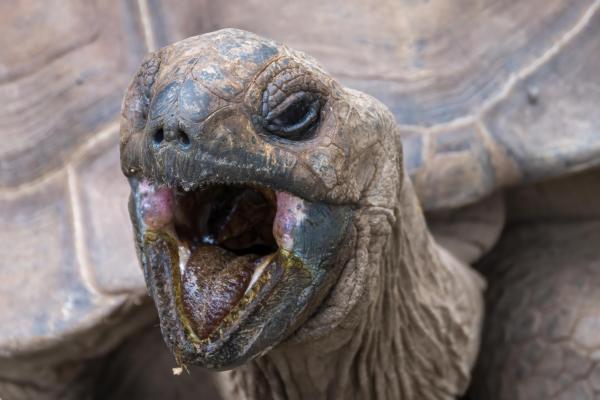
Turtles are long-lived reptiles that are characterized by the presence of a strong shell. This carapace covers their body, allowing them to protect their organs from predators. The diet of turtles varies according to species, of which there are over three hundred. Some live on land, freshwater or even the sea, with habitat also being a significant factor in what a turtle eats. Since turtles can be both carnivorous and herbivorous, it is also an important question to ask how a turtle eats?
At thedailyECO, we investigate how different turtles eat by asking do turtles have teeth? We look at the anatomy of different types of turtles, finding out whether land, freshwater or sea turtles have teeth.
Do sea turtles have teeth?
The direct answer is that sea turtles do not have teeth. Instead of teeth, sea turtles have a horny sheath over their mouths known as a rhamphotheca. This is a type of beak which is similar to those of many birds. It is made up of an upper mandible (rhinotheca) and a lower mandible (gnathotheca). These sea turtle beaks are made from keratin, the same substance used to make up claws, scales and hair in other animals, among other body parts. The edge of a turtle's beak is known as a tomium.
Not all types of sea turtles have the same type of beak. Since they have different diets, each rhamphotheca is adapted to allow them to ingest their desired food. Below, we look at some of the best known types of sea turtle and the type of beak they use to eat:
- Green sea turtle (Chelonia mydas): the horny beak of a green turtle is serrated with short pointed cusps. This serrated texture allows them to cut algae and sea grass that are attached to rocks or the ocean floor. Since they are herbivorous animals, they do not need to eat harder material, so their beak is not as sharp as some turtles.
- Loggerhead sea turtle (Caretta caretta): this is a carnivorous sea turtle has a very robust beak with very sharp tomium. This allows them to break the shells, calcareous or chitinous exoskeletons of certain mollusks and crustaceans to eat the flesh within.
- Hawksbill sea turtle (Eretmochelys imbricata): has a somewhat elongated beak capable of being inserted between coral reefs or rocky substrates to capture sponges, mollusks and crustaceans.
- Leatherback sea turtle (Dermochelys coriacea): their beak is thin and sharp and has a hooked tomium on the rhinotheca. They are not teeth, but these turtles do have spines on their esophagus which trap food inside and prevent them from escaping before they can be ingested.

Do freshwater turtles have teeth?
Like sea turtles, freshwater-dwelling turtles do not have teeth in their jaws, but instead have a strong horny beak (rhamphotheca). Here we present five species of freshwater turtles with beaks:
- Black spine-neck swamp turtle (Acanthochelys spixii)
- Hilaire’s toadhead turtle (Phrynops hilarii)
- Eastern long-necked turtle (Chelodina longicollis)
- D'Orbigny's slider (Trachemys dorbigni)
- Red-eared slider (Trachemys scripta elegans)
If you want to learn about other reptiles and how they live, take a look at our comparison on the differences between crocodiles and alligators.

Do land turtles have teeth?
We may also ask ‘do tortoises have teeth?’, since many land turtles are known as tortoises. However, they are not so exclusively. Although all tortoises are types of turtles, not all land turtles are considered tortoises. As with sea turtles and freshwater turtles, land turtles have a keratinized beak which has varying levels of serration. They use this to catch, kill and swallow food if they are carnivorous and to chop vegetation if they are herbivorous.
Here we share 5 species of tortoises that have a robust beak for cutting, crushing or swallowing food:
- Chaco tortoise (Chelonoidis chilensis)
- Aldabra giant tortoise (Aldabrachelys gigantea)
- African spurred tortoise (Centrochelys sulcata)
- Greek tortoise (Testudo graeca)
- Indian star tortoise (Geochelone elegans)

What does a turtle's mouth look like?
As we mentioned in the previous sections, the oral cavity of turtles does not have teeth. They are formed by a keratinized callous sheath or horny beak arranged on the maxilla and mandible bones, which is called a rhamphotheca. This bill is thickened both rostrally (toward the front of the head) and laterally.
The tongue is fleshy and helps in chewing. It has a squamous epithelium with muscle fibers, taste buds, pigments, and mucus-producing glands. Unlike other reptiles, a turtle's tongue is immobile. The oropharyngeal mucosa is rich in mucus-producing glands, something which both aids in digestion and helps protect against disease.
Sea turtles have papillae in the form of elongated conical spines with pointed tips directed inward, the function of which is still not completely understood. These papillae are developed in marine turtles, but also in some species of land turtles. It is known that the spines of the leatherback sea turtle (Dermochelys coriacea) are abundant and are aligned with the tips backwards. Turtles of this species are capable of moving them voluntarily during swallowing, thus preventing prey with slippery and gelatinous bodies from easily escaping.
Although we mentioned throughout the article that turtles do not have teeth, there is an exception. This is because gestating turtles develop something known as the egg tooth. This is a hard structure which is actually a true tooth, similar to the teeth humans have in their mouths. It is made of calcium and usually grows at the front of the hatchling's beak.
The purpose of the egg tooth has everything to do with its name. Although they will not need the tooth later in life, turtle hatchlings need it to break their shell when they being born. With the help of body movement, baby turtles use the egg tooth to break through the shell and hatch. It is located on the maxilla of the bill and disappears almost immediately upon hatching .
People who study reptiles such as the turtle are known as herpetologists, scientists who also study amphibians. Learn more about amphibian research with our article on the difference between toads and frogs.
If you want to read similar articles to Do Turtles Have Teeth?, we recommend you visit our Facts about animals category.
- Marquez, R., & Del Carmen Farías, M. (2000). Sea turtles and our time.
- Tracchia, A. C. (2018). Medicine in chelonians and other reptiles. Retrieved from: https://www.fundacionazara.org.ar/img/libros/medicina-de-quelonios.pdf
- Wyneken, J. (2004). The Anatomy of Sea Turtles.